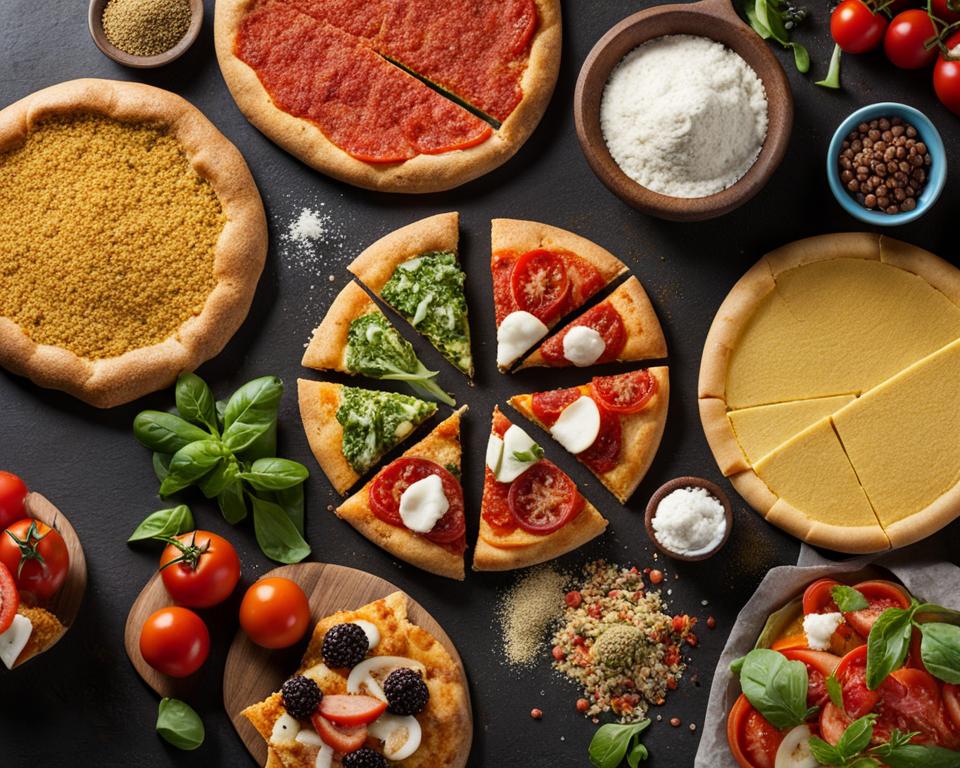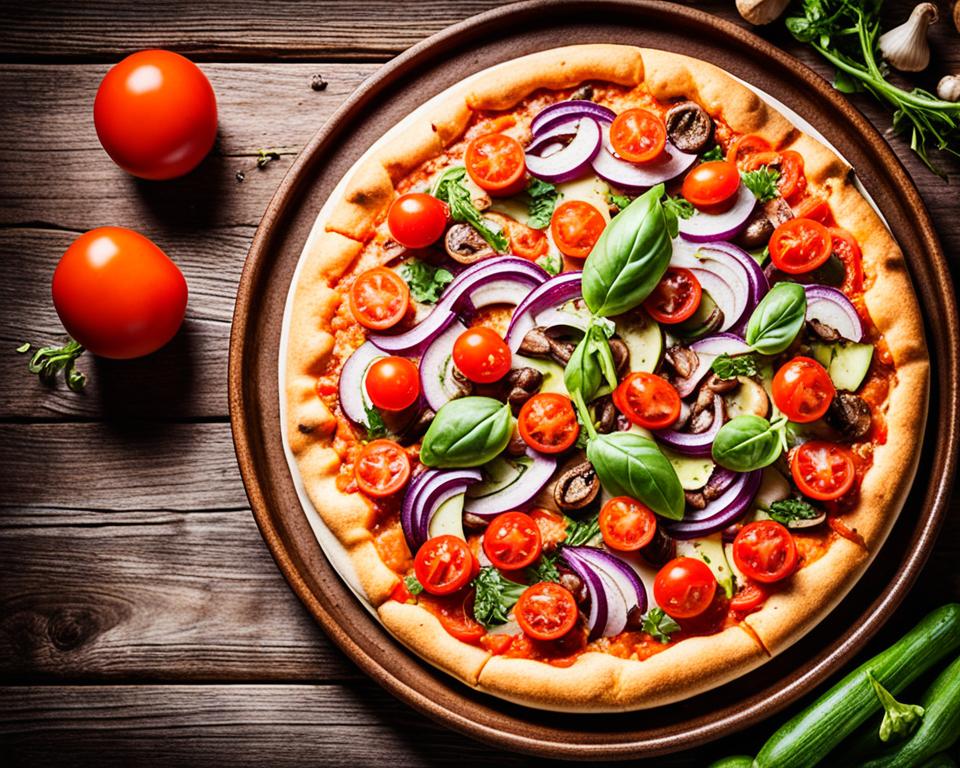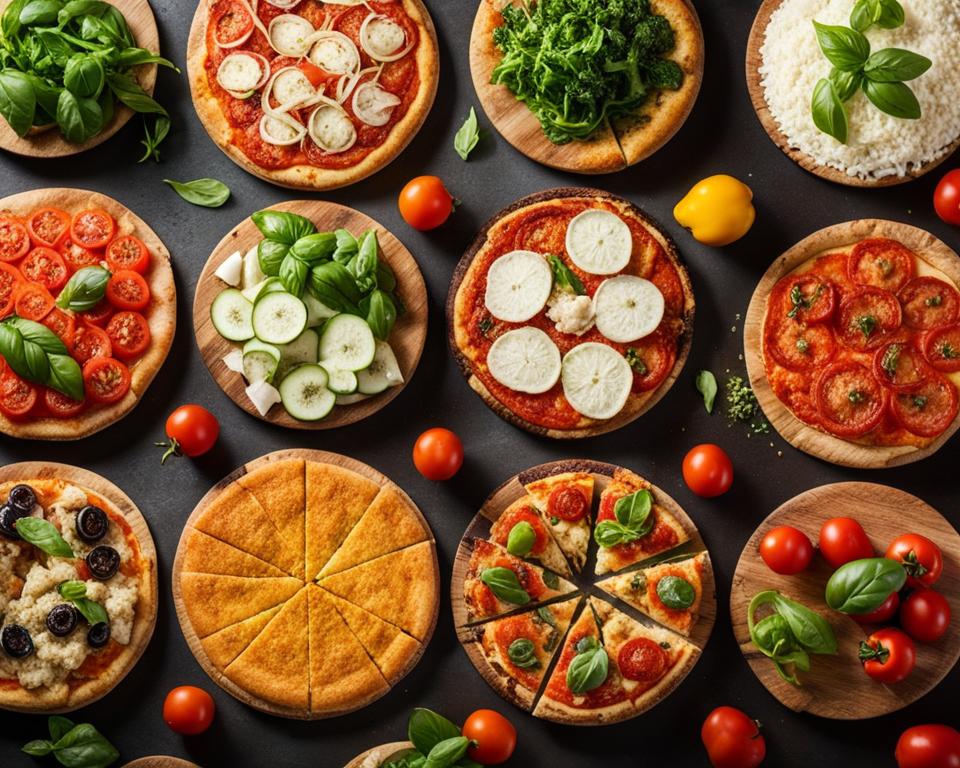Are you on a gluten-free diet but still crave a delicious slice of pizza? Look no further! In this article, we will explore the best gluten-free pizza crust options available to cater to your dietary needs without compromising on flavor. Whether you prefer store-bought crusts or homemade recipes, we have you covered with a variety of options to choose from. We will also discuss some alternative crusts and tips for achieving a crispy texture.
Key Takeaways:
- Discover the top gluten-free pizza crust brands and recipes for easy and homemade options.
- Explore alternative crusts like zucchini and cauliflower for a unique twist on your gluten-free pizza.
- Learn expert tips for achieving a crispy gluten-free pizza crust.
- Evaluate the nutritional aspects of different crusts to make healthier choices.
- Find gluten-free pizza crusts tailored to specific dietary restrictions like vegan, paleo, keto, or low FODMAP.
Best Store-Bought Gluten-Free Pizza Crusts
If you’re looking for convenience, there are several gluten-free pizza crust brands available in the market. Whether you have a busy schedule or prefer the ease of store-bought options, these crusts provide a delicious gluten-free base for your pizza creations. We have reviewed and narrowed down the top choices based on taste, texture, and ingredient quality so that you can make an informed decision.
Cappello’s Paleo Gluten-Free Pizza Crust
A popular choice among gluten-free pizza enthusiasts, Cappello’s Paleo Gluten-Free Pizza Crust offers a satisfyingly crispy texture and a robust flavor. Made with a blend of almond flour, arrowroot flour, cage-free eggs, and tapioca flour, this crust is not only gluten-free but also grain-free and dairy-free, making it suitable for a variety of dietary needs. It holds up well to a variety of toppings and bakes to perfection.
Banza Chickpea Flour Gluten-Free Pizza Crust
For those seeking a high-protein gluten-free pizza crust, Banza Chickpea Flour Gluten-Free Pizza Crust is an excellent choice. Made with chickpea flour, tapioca, pea protein, and xanthan gum, this crust delivers a hearty and nutritious base that is both gluten-free and vegan-friendly. It provides a slightly nutty flavor and a soft, but not too doughy, texture. It pairs well with a variety of toppings and is a great option for those looking to incorporate more plant-based protein into their diet.
O’Doughs Gluten-Free Pizza Crust
If you prefer a thinner and lighter gluten-free pizza crust, O’Doughs Gluten-Free Pizza Crust is worth considering. Made with a blend of rice flour, tapioca flour, and potato flour, this crust offers a delicate and crispy texture. It has a neutral flavor that allows the toppings to shine. It is also free from gluten, dairy, soy, and nuts, making it suitable for individuals with multiple dietary restrictions.
Simple Kneads Gluten-Free Pizza Dough
Simple Kneads Gluten-Free Pizza Dough is a versatile option that caters to various dietary preferences and allergies. Made with a blend of whole grain teff flour, sorghum flour, and potato starch, this crust is not only gluten-free but also vegan and free from other common allergens. The dough has a unique nutty flavor and bakes into a crisp yet tender crust. It’s a great choice for those with multiple dietary restrictions or food sensitivities.
| Brand | Ingredients | Taste | Texture | Price |
|---|---|---|---|---|
| Cappello’s Paleo Gluten-Free Pizza Crust | Almond flour, arrowroot flour, cage-free eggs, tapioca flour | Robust and flavorful | Satisfyingly crispy | $$ |
| Banza Chickpea Flour Gluten-Free Pizza Crust | Chickpea flour, tapioca, pea protein, xanthan gum | Subtly nutty | Soft and hearty | $$ |
| O’Doughs Gluten-Free Pizza Crust | Rice flour, tapioca flour, potato flour | Neutral flavor | Thin and crispy | $ |
| Simple Kneads Gluten-Free Pizza Dough | Whole grain teff flour, sorghum flour, potato starch | Nutty and unique | Crisp yet tender | $$ |
These are just a few examples of the best store-bought gluten-free pizza crusts available. Depending on your personal preferences and dietary needs, you may find that one of these options suits you perfectly. Remember to experiment with different toppings and cooking methods to create a truly delicious gluten-free pizza experience.
Homemade Gluten-Free Pizza Crust Recipes
For those who enjoy the process of making pizza from scratch, we have a selection of homemade gluten-free pizza crust recipes for you to try. Whether you’re following a gluten-free diet due to dietary restrictions or personal preference, these recipes will allow you to enjoy a delicious pizza without the gluten. From a socca crust made with chickpea flour to a cauliflower crust, these recipes offer different flavors and textures that will satisfy your pizza cravings.
Creating your own homemade gluten-free pizza crust allows you to have full control over the ingredients and customize it according to your taste preferences. Plus, making it from scratch can be a fun and rewarding culinary experience. You’ll feel a sense of accomplishment knowing that you’ve created a delicious gluten-free crust that everyone will enjoy.
Socca Crust Recipe
If you’re looking for a simple and easy gluten-free pizza crust, the socca crust is a fantastic option. Socca is a traditional chickpea flour pancake from the south of France, and it makes a fantastic gluten-free pizza crust. Here’s how you can make it:
- In a bowl, whisk together 1 cup of chickpea flour, 1 cup of water, 1 tablespoon of olive oil, and salt to taste.
- Let the batter rest for at least 30 minutes to allow the flavors to meld together.
- Preheat your oven to 450°F (230°C).
- Heat a cast-iron skillet over medium-high heat and lightly oil it.
- Pour the socca batter into the skillet and cook for 3-4 minutes until the edges start to crisp.
- Transfer the skillet to the preheated oven and bake for an additional 10-12 minutes until the crust is golden and crispy.
- Remove the socca crust from the oven and let it cool slightly before adding your favorite pizza toppings.
This socca crust recipe provides a crispy, flavorful base for your gluten-free pizza. It’s also incredibly versatile, allowing you to experiment with different toppings and flavors to create your perfect pizza.
Cauliflower Crust Recipe
Another popular option for a gluten-free pizza crust is the cauliflower crust. It’s a low-carb alternative to traditional pizza crusts and offers a lighter texture. Here’s how you can make a cauliflower crust:
- Preheat your oven to 425°F (220°C) and line a baking sheet with parchment paper.
- Rinse and chop a medium-sized head of cauliflower into florets.
- In a food processor, pulse the cauliflower florets until they resemble fine rice.
- Transfer the cauliflower rice to a microwave-safe bowl and microwave for 5-6 minutes to soften it.
- Place the softened cauliflower rice in a clean kitchen towel and squeeze out as much liquid as possible.
- In a bowl, combine the cauliflower rice, 1 egg, ½ cup of grated cheese (such as mozzarella or cheddar), and seasonings of your choice.
- Spread the cauliflower mixture onto the prepared baking sheet in a thin, even layer.
- Bake the crust for 15-20 minutes or until it’s golden and crispy.
- Remove the cauliflower crust from the oven and let it cool slightly before adding your favorite pizza toppings.
This cauliflower crust recipe provides a great alternative for those looking to reduce their carbohydrate intake and increase their vegetable consumption. It’s a creative way to enjoy pizza while still adhering to a gluten-free lifestyle.
Feel free to experiment with different toppings, sauces, and seasonings to create your own unique gluten-free pizza experience. Whether you prefer a classic margherita or a loaded veggie pizza, these homemade gluten-free crusts will provide a satisfying base for all your flavor combinations.
| Socca Crust Recipe | Cauliflower Crust Recipe |
|---|---|
Alternative Gluten-Free Pizza Crusts
If you’re looking for unique and alternative options for gluten-free pizza crusts, there are several creative choices available. These alternatives not only cater to your dietary needs but also offer exciting flavors and textures. Let’s explore some of the popular options:
Zucchini Crusts
One delicious and nutritious alternative to traditional pizza crusts is zucchini crusts. Made by grating and straining zucchini, these crusts are low-carb and vegetable-based, making them a hit among health-conscious individuals. With the right techniques and binders, you can achieve a crispy texture that rivals traditional crusts.
Cauliflower Crusts
Cauliflower has become a star ingredient in the gluten-free world, and it also shines as an alternative pizza crust. With its mild flavor and versatile nature, cauliflower can be transformed into a crust that is both nutritious and delicious. The process involves finely chopping the cauliflower, squeezing out excess moisture, and combining it with other ingredients to form a dough-like consistency. Once baked, the result is a flavorful and crispy crust that will satisfy your pizza cravings.
Cassava Flour Flatbread Crusts
If you’re looking for a unique gluten-free option that offers a slightly different taste and texture, consider cassava flour flatbread crusts. Cassava flour is derived from the root of the cassava plant and provides a gluten-free alternative to traditional wheat flour. The resulting flatbread crusts are light, airy, and crispy, adding a delightful twist to your pizza experience.
| Alternative Gluten-Free Pizza Crusts | Taste | Texture | Preparation Time |
|---|---|---|---|
| Zucchini Crusts | Mild and versatile | Crispy when baked correctly | Medium |
| Cauliflower Crusts | Mild and slightly nutty | Crispy on the edges, tender in the center | Medium |
| Cassava Flour Flatbread Crusts | Mild and slightly sweet | Light and airy | Low |
Each of these alternative gluten-free pizza crusts offers a unique twist on the classic pizza experience. Whether you prefer the mild flavor of zucchini, the slightly nutty taste of cauliflower, or the lightness of cassava flour, these crusts are sure to delight your taste buds. Experiment with different toppings and sauces to create a personalized pizza masterpiece!
Crispy Gluten-Free Pizza Crust Tips
Achieving a crispy texture with gluten-free pizza crust can be a challenge due to the absence of gluten. However, with the right techniques and a bit of creativity, you can still enjoy a perfectly crispy gluten-free pizza crust. Here are some expert tips to help you elevate the crunchiness of your crust:
- Pre-bake the crust: Before adding any toppings, pre-bake your gluten-free pizza crust for a few minutes. This helps to remove excess moisture and creates a sturdy base for your toppings.
- Choose the right ingredients: Opt for gluten-free flours that are naturally crispier, such as rice flour, almond flour, or cornmeal. These ingredients add a delightful crunch to your crust.
- Add binders: Adding binders like eggs or xanthan gum to your pizza dough can help improve the texture and crispiness of your crust. These ingredients help hold the dough together and prevent it from becoming too crumbly.
- Roll it thin: If you prefer a crispier pizza crust, roll your dough thinner. Thinner crusts tend to become crispier during baking.
- Use a pizza stone or baking steel: To achieve that professional-level crispiness, use a preheated pizza stone or baking steel. These tools help distribute heat evenly and create a crispy crust.
- Top strategically: Be mindful of the moisture content of your pizza toppings. If using ingredients like fresh tomatoes or mozzarella, drain them well or use less moisture-laden toppings to prevent sogginess.
By following these tips, you can create a crispy gluten-free pizza crust that rivals its gluten-containing counterparts. Experiment with different combinations of flours, binders, and baking methods to find your perfect crispy crust recipe.
“Pre-baking the crust and using the right ingredients are key to achieving a crispy gluten-free pizza crust.” – Chef Maria Smith
| Technique | Advantages | Disadvantages |
|---|---|---|
| Pre-baking the crust | – Removes excess moisture – Creates a sturdy base for toppings |
– Requires an extra step – Can overcook the crust if not monitored |
| Choosing the right ingredients | – Adds natural crispiness – Enhances flavor |
– May require experimenting with different flour combinations |
| Adding binders | – Improves texture and stability – Helps prevent a crumbly crust |
– May not be suitable for certain dietary restrictions (e.g., vegan) |
| Rolling the dough thin | – Promotes crispiness – Allows for quicker baking |
– Thinner crusts may be more delicate |
| Using a pizza stone or baking steel | – Evenly distributes heat – Creates a professional-level crunch |
– Requires additional equipment |
| Topping strategically | – Prevents sogginess – Enhances flavor balance |
– Limited use of moisture-laden toppings |
Gluten-Free Pizza Crust Nutrition
When it comes to choosing a gluten-free pizza crust, considering its nutritional profile is important. Understanding the calorie counts, carbohydrate content, fiber content, and protein content of different crust options can help you make informed decisions about your diet. Additionally, selecting healthier options and incorporating nutritious toppings can transform your gluten-free pizza into a well-rounded meal.
Let’s take a closer look at the nutritional aspects of gluten-free pizza crust:
Calorie Counts
Calorie counts vary depending on the type of gluten-free pizza crust you choose. While some store-bought crusts may have higher calorie counts due to added fats and sugars, homemade crusts often give you more control over the ingredients and can be lighter in calories.
Carbohydrate Content
Gluten-free pizza crusts are typically made with alternative flours like rice flour, quinoa flour, or almond flour. These flours have different carbohydrate compositions compared to traditional wheat flour. It’s worth noting that some gluten-free crusts may contain higher carbohydrate content. However, this can vary depending on the recipe or brand.
Fiber Content
Depending on the ingredients used, gluten-free pizza crusts can provide a good source of dietary fiber. Whole grain flours, such as brown rice flour or teff flour, can contribute more fiber to the crust. Fiber is essential for digestive health and can help you feel fuller for longer.
Protein Content
Gluten-free pizza crusts can vary in their protein content. Some crusts may contain higher protein levels if they include ingredients like chickpea flour or quinoa flour. Adding protein-rich toppings like lean meats, tofu, or beans can further enhance the protein content of your gluten-free pizza.
In summary, understanding the nutritional aspects of gluten-free pizza crusts can help you make choices that align with your dietary goals. Whether you’re looking for lower calorie options, higher fiber choices, or increased protein content, there are gluten-free crust options available to suit your needs.

| Crust Type | Calories | Carbohydrates (g) | Fiber (g) | Protein (g) |
|---|---|---|---|---|
| Cauliflower Crust | 120 | 10 | 2 | 8 |
| Brown Rice Flour Crust | 160 | 20 | 4 | 3 |
| Almond Flour Crust | 200 | 15 | 3 | 8 |
| Chickpea Flour Crust | 180 | 25 | 5 | 12 |
Tips for Evaluating Gluten-Free Pizza Crusts
With a wide variety of gluten-free pizza crusts available in the market, it can be overwhelming to choose the right one. When evaluating and selecting a gluten-free pizza crust, it’s important to consider factors such as ingredient quality, certifications, taste, and texture. By paying attention to these factors, you can make an informed decision and enjoy a satisfying gluten-free pizza experience.
1. Ingredient Quality
Start by checking the ingredient list of the gluten-free pizza crust. Look for crusts that use high-quality gluten-free flours and avoid artificial additives or preservatives. Choosing crusts made with whole grains or alternative flours like almond or chickpea can provide additional nutritional benefits.
2. Certifications
Look for gluten-free pizza crusts that have certifications from trusted organizations such as the Gluten-Free Certification Organization (GFCO) or the Celiac Support Association (CSA). These certifications indicate that the crust has undergone rigorous testing and meets the standards for gluten-free products.
3. Taste and Texture
Taste and texture are crucial when it comes to enjoying a gluten-free pizza. Read reviews or ask for recommendations from friends or online communities to get an idea of how the crust tastes. Look for descriptions like “crispy,” “chewy,” or “light” to find a crust that suits your personal preferences.
4. Varieties and Customization
Consider the variety of gluten-free pizza crusts available from a particular brand. Some brands offer different flavors or styles, such as thin crust or deep dish. If you enjoy experimenting with toppings or want to customize your pizza experience, look for crusts that allow for creative freedom.
“Finding the right gluten-free pizza crust can be a journey of trial and error. Don’t be afraid to experiment and try different options until you find the perfect crust for your taste buds!”
5. Price and Value
The price of gluten-free pizza crusts can vary depending on the brand and size. Consider your budget and compare prices to find a crust that provides good value for money. Keep in mind that some crusts may come in multiple packs, offering cost savings in the long run.
6. Availability
Check the availability of the gluten-free pizza crusts you’re interested in. Some crusts may be readily available in local grocery stores, while others might require ordering online. Choose a crust that is convenient for you to access to ensure a hassle-free pizza-making experience.
By considering these tips, you can confidently evaluate gluten-free pizza crusts and choose the one that suits your dietary needs and preferences. Enjoy your delicious gluten-free pizza creation!
| Ingredients | Certifications | Taste | Texture | Varieties | Price Range | Availability |
|---|---|---|---|---|---|---|
| Whole grain flours, no artificial additives | GFCO, CSA | Crisp and flavorful | Light and airy | Thin crust, deep dish | $8-12 per crust | Available in local stores and online |
| Almond flour, organic ingredients | GFCO | Rich and nutty | Dense and chewy | Original, garlic herb | $10-15 per crust | Available online |
| Chickpea flour, no added sugar | GFCO | Savory and earthy | Crispy and sturdy | Traditional, cauliflower crust | $6-10 per crust | Available in local stores |
Gluten-Free Pizza Crusts for Special Diets
If you have specific dietary restrictions, such as vegan, paleo, keto, or low FODMAP, you can still enjoy a delicious gluten-free pizza with the right crust. There are a variety of options available that cater to your dietary needs without compromising on taste or texture. Here, we highlight crusts that meet these specific dietary requirements and provide information on their ingredients and certifications.
Vegan Gluten-Free Pizza Crust
For those following a vegan lifestyle, there are gluten-free pizza crusts that are free from all animal products. These crusts are typically made with plant-based ingredients and do not contain any dairy, eggs, or honey. Brands like Caulipower and Simple Mills offer vegan gluten-free pizza crust options that deliver both convenience and taste.
Paleo Gluten-Free Crust
If you’re adhering to a paleo diet, you can still enjoy pizza without compromising your dietary goals. Paleo-friendly gluten-free pizza crusts are usually grain-free, dairy-free, and processed sugar-free. They are often made with ingredients like almond flour, tapioca flour, and eggs. Brands like Cappello’s and Against the Grain offer paleo-friendly crusts that are both flavorful and satisfying.
Keto Gluten-Free Crust
For those following a ketogenic (keto) diet, there are gluten-free pizza crust options that are low in carbohydrates and high in healthy fats. These crusts typically contain ingredients like almond flour, coconut flour, and psyllium husk. Brands like Real Good Foods and Cali’flour Foods offer keto-friendly crusts that fit within your macronutrient goals while still delivering a delicious pizza experience.
Low FODMAP Gluten-Free Crust
If you’re following a low FODMAP diet to manage digestive issues, there are gluten-free pizza crust options available that are low in fermentable carbohydrates. These crusts are typically made with ingredients that are low in FODMAPs, such as rice flour, tapioca flour, and gluten-free oats. Brands like FODY Foods and NoOodle offer low FODMAP-friendly crusts that are gentle on your gut while still allowing you to enjoy a scrumptious pizza.
No matter what dietary restrictions you have, there is a gluten-free pizza crust option out there for you. These special diet-friendly crusts ensure that you can still indulge in a tasty pizza while sticking to your dietary needs. So go ahead and experiment with these crusts to create a customized and satisfying pizza experience!

| Crust Type | Brands | Ingredients | Certifications |
|---|---|---|---|
| Vegan Gluten-Free | Caulipower | Gluten-free flour blend (brown rice flour, tapioca flour, white rice flour, potato starch), water, extra virgin olive oil, cauliflower, rice starch, flaxseed | Non-GMO Project Verified, Certified Gluten-Free, Certified Vegan |
| Paleo Gluten-Free | Cappello’s | Almond flour, cage-free eggs, arrowroot flour, organic coconut milk, xanthan gum, sea salt | Certified Gluten-Free, Paleo Certified, Grain-Free Certified |
| Keto Gluten-Free | Real Good Foods | Chicken breast, parmesan cheese, water, buffalo sauce (aged cayenne red peppers, distilled vinegar, water, salt, garlic powder), spices, pepperoni (pork, salt, contains 2% or less of water, spices, dextrose, lactic acid starter culture, oleoresin of paprika, flavoring, sodium nitrite, BHA, BHT, citric acid) | Grain-Free, Keto-Friendly |
| Low FODMAP Gluten-Free | FODY Foods | Brown rice flour, tapioca starch, potato starch, potato flour, organic coconut palm sugar, yeast, xanthan gum, salt, sodium acid pyrophosphate, mono calcium phosphate | Low FODMAP Certified, Gluten-Free Certified |
Expert Insights on Gluten-Free Pizza Crusts
To provide a well-rounded perspective on gluten-free pizza crusts, nutrition experts and registered dietitians are sharing their recommendations, tips, and personal experiences with gluten-free crusts. Their expertise will help you make informed decisions and enhance your gluten-free pizza-making skills.
Expert Recommendation 1: Enhancing Flavor and Texture
“When it comes to gluten-free pizza crusts, I recommend using a combination of gluten-free flours such as rice flour, tapioca flour, and almond flour. This blend helps to achieve a light and crispy texture while adding depth of flavor. Experiment with different ratios until you find the perfect balance for you.” – Dr. Sarah Johnson, Registered Dietitian
Expert Recommendation 2: Binding Ingredients
“For a successful gluten-free pizza crust, it’s important to use binders such as xanthan gum or psyllium husk. These ingredients help replace the functionality of gluten and hold the crust together. Be sure to follow the recipe measurements carefully to avoid any texture issues.” – Chef Michael Thompson, Culinary Expert
Expert Recommendation 3: Preparing the Dough
“When working with gluten-free pizza dough, I suggest letting the dough rest for at least 30 minutes before shaping and baking. This resting time allows the flours to hydrate, resulting in a more manageable and elastic dough. It also helps improve the texture of the crust.” – Emily Davis, Gluten-Free Baker
By incorporating these expert recommendations into your gluten-free pizza crust preparations, you can elevate the flavor, texture, and overall quality of your homemade pizzas.
| Expert | Key Recommendation |
|---|---|
| Dr. Sarah Johnson | Use a blend of gluten-free flours for flavor and texture |
| Chef Michael Thompson | Include binders like xanthan gum or psyllium husk |
| Emily Davis | Allow the dough to rest before shaping and baking |
Conclusion
In conclusion, finding the perfect gluten-free pizza crust can be challenging but rewarding. Throughout this article, we have explored various options to cater to your dietary needs without compromising on flavor. Whether you prefer store-bought crusts or homemade recipes, there is a wide range of choices available. We have also discussed alternative crusts and provided tips for achieving a crispy texture.
When selecting the best gluten-free pizza crust for your preferences, it is important to consider factors such as taste, texture, ingredient quality, and any specific dietary requirements you may have. By taking these factors into account, you can ensure a delightful gluten-free pizza experience.
With the right crust, you can relish a delicious and satisfying gluten-free pizza that meets your needs. Whether you opt for a store-bought crust or enjoy the process of making it from scratch, the key is to experiment and find the option that suits your taste buds and dietary restrictions best. So go ahead, explore the gluten-free pizza crust options discussed in this article, and indulge in a flavorful pizza experience.
FAQ
What are some top gluten-free pizza crust options available?
Some top gluten-free pizza crust options available include Cappello’s Paleo Gluten-Free Pizza Crust and Banza Chickpea Flour Gluten-Free Pizza Crust.
What are the best store-bought gluten-free pizza crusts?
The best store-bought gluten-free pizza crusts include Cappello’s Paleo Gluten-Free Pizza Crust and Banza Chickpea Flour Gluten-Free Pizza Crust.
What are some homemade gluten-free pizza crust recipes?
Some homemade gluten-free pizza crust recipes include socca crust made with chickpea flour and cauliflower crust.
What are some alternative gluten-free pizza crusts?
Alternative gluten-free pizza crust options include zucchini crusts, cauliflower crusts, and cassava flour flatbread crusts.
How can I achieve a crispy texture with gluten-free pizza crust?
Some tips to achieve a crispy texture with gluten-free pizza crust include pre-baking the crust and adding toppings strategically.
What are the nutritional aspects of gluten-free pizza crusts?
The nutritional aspects of gluten-free pizza crusts vary, but you can choose options based on their calorie counts, carbohydrate content, fiber content, and protein content.
How can I evaluate and choose a gluten-free pizza crust?
When evaluating gluten-free pizza crusts, consider factors such as ingredient quality, certifications, taste, and texture.
Are there gluten-free pizza crusts available for special diets?
Yes, there are gluten-free pizza crusts available for special diets, including vegan, paleo, keto, and low FODMAP options.
What do experts say about gluten-free pizza crusts?
Experts provide recommendations, tips, and personal experiences with gluten-free crusts to help you make informed decisions.





